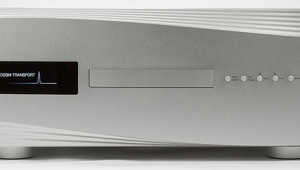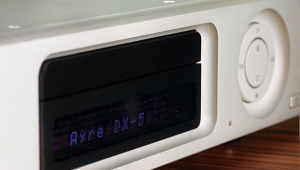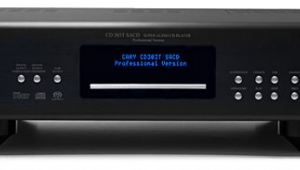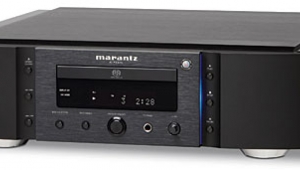| Columns Retired Columns & Blogs |
dCS Puccini SACD playback system Page 4
Even so, Sonata didn't approach Zenph Studios' recent re-creation of Rachmaninoff performing his arrangement of Kreisler's Liebeslied, from Rachmaninoff Plays Rachmaninoff (CD, RCA Red Seal 748971). Recorded by Richard King with three DPA4006 omnis, this is perhaps the best recording of a piano I have heard. Upsampled to DSD by the Puccini and clocked by the U-Clock, there was a richness, a believability to the sound of the restored 1909 Steinway D on the Simaudio-driven Aerial 20T V2s that almost made me forget I was listening to recorded sound. Almost.
The Puccini's low frequencies had a convincing combination of pat and purr. Tony Levin's double-stopped bass-guitar riff on "Don't Give Up," from Peter Gabriel's So (SACD/CD, Geffen Chronicles 069 0493 626-2), hung in space at the front of the stage, superbly separated from the synths that paint the backing wash of sound and from Gabriel's plaintive baritone. And when Levin plays a single line in the song's coda, with much of its energy in the same register as the accompanying kick drum, there was no confusion between the two instruments. Similarly, in Quincy Jones' kickass arrangement of Marvin Gaye's "What's Going On?," from Jones' Smackwater Jack (CD, A&M 393 037-2), the switching between the funky bass lines of Ray Brown's acoustic instrument underlying the intro and the almost identical groove in the verses from Chuck Rainey's electric instrument was maximally clear. And when the arrangement switches back to a swinging four-in-the-bar from Ray Brown for Hubert Laws' flute solo and Freddie Hubbard's flugelhorn solo, the hardware stepped out of the way to let the music rock!
Played back via USB and the U-Clock, one of my 2009 "Records To Die For," the Dunedin Consort's performance of J.S. Bach's St. Matthew Passion (Linn Records 24-bit/88.2kHz Studio Master FLAC files), demonstrated everything the Puccini did right: the stately dotted ostinato of the opening chorale and its dark-hued baroque oboes, the fragile, exposed nature of the solo voices and the one-to-a-part chorus, the gruff quality of the double basses, the dome of ambience surrounding the minimal forces—all were presented with palpability and a righteous sense of musical flow.
Comparisons
The two disc players residing in my system before the arrival of the dCS Puccini, the Ayre C-5xeMP and the Meridian 808i.2, are among the finest I have auditioned. How did the newcomer fare?
For these comparisons, I matched levels at 1kHz to within 0.1dB. For the first series of tests, I drove one of the Puccini's digital inputs with the digital output of the Ayre, or one of the Meridian's inputs with the Puccini's data output. This way, there would be no synchronization artifacts that would indicate when a switch was made. However, this did handicap the slaved player: it would be clocked not internally, but by the phase-locked loop of its data receiver. I therefore also performed side-by-side comparisons with all three players playing copies of the same disc.
First, comparing the dCS with the Ayre, the sounds of the players were virtually identical on SACD. If there was a difference, it wasn't one I could use to tell which machine was playing (at least in the context of my system). On CD, with the Puccini upsampling to DSD and the Ayre using its MP filter, low frequencies sounded equally full and well defined. The Ayre's soundstage was set a little farther back than the dCS's, though the Puccini presented individual images within that stage in a slightly more delineated, slightly less palpable manner. The Ayre's highs sounded slightly wispier on close-miked violins (the performance of Mozart's Piano Quartet in g on Editor's Choice, Stereophile STPH016-2), the Puccini very slightly airier, but at this level of performance, the differences were small.
The Meridian, with its apodizing filter, excels at CD reproduction but won't play SACDs, of course. Again with levels matched at 1kHz, the audible differences were very small. In the end, I slightly preferred the Meridian, which I felt offered a small improvement in image palpability but a slight loss in low-frequency tautness. I will discuss these comparisons in more detail in a future issue.
Summing Up
At $17,995, the dCS Puccini player is expensive but sounds excellent. Adding the U-Clock takes its sound quality to the max and adds the USB input, which will become increasingly relevant as audiophiles transfer their music collections to hard drives. Overall, there was something very right about the sound of the dCS Puccini system, not only when playing SACDs (which always tend to sound good) or well-recorded CDs, but also when playing PCM data sourced from my Mac mini via USB and the U-Clock.
Playing CDs, the Meridian 808i.2, with its apodizing filter, still leads the field, but as dCS uses a programmable FPGA as the base for its DSP engine, I wouldn't be surprised if they also introduce more filters for the Puccini in the future.
Highly recommended.
- Log in or register to post comments




































